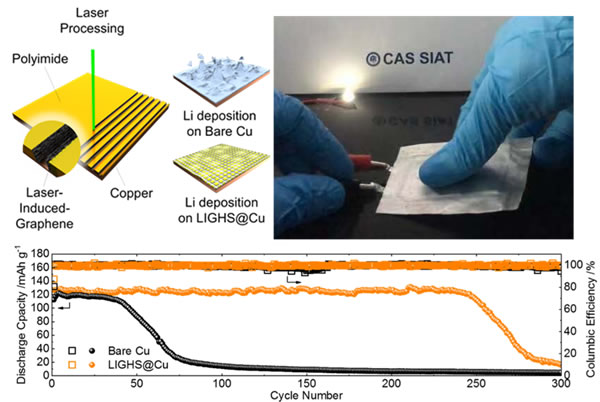On August 21st, the electrochemical team of the Photonic Information and Energy Materials Research Center of the Shenzhen Institute of Advanced Technology, Chinese Academy of Sciences made new progress in the direction of long-acting lithium battery cells. Related achievements were published in the journal "Facile Patterning of Laser-induced-Graphene with Tailored Li Nucleation Kinetics for Stable Lithium Metal Batteries" In Advance Energy Materials, the first author of the article is Master Jingyi, the corresponding author is assistant researcher Lu Ziheng and researcher Yang Chunlei. As the cruising range of electric vehicles increases, the energy density of power batteries is also increasing. The energy density of the lithium ion battery with ternary material / graphite system currently used has reached 230Wh / kg-260Wh / kg, and the lithium metal anode is used. It is an important way to further achieve 500Wh / kg energy density. Lithium metal anode is an ideal anode material because of its ultra-high theoretical specific capacity (3860 mAh / g) and lowest oxidation-reduction potential (3.04 V vs. SHE), and has excellent electrical conductivity, but lithium metal anode In the case of a large current density, it will lead to the growth of dendrites. On the one hand, it will reduce the service life of the battery. On the other hand, excessive growth of lithium dendrites will pierce the separator and cause short circuit of the positive and negative electrodes, causing serious safety accidents. The problem of lithium dendrites has become the biggest obstacle to the application of lithium metal. In order to solve the above problems, the research team has developed a method for rapidly preparing three-dimensional graphene current collector by laser direct writing technology. Thanks to the special defect chemistry of graphene in the current collector, the nucleation and growth kinetics of lithium metal are obtained Effective regulation. Using this technology, a lithium metal full battery based on a lithium iron phosphate positive electrode can be cycled 250 times with extremely high material load (15 mg / cm2) and limited lithium metal supply (N / P ratio = 5), with a capacity loss of less than 10%. The method developed by this research can be carried out in air, and can be prepared on a large scale using a roll-to-roll method, and has industrial potential. In addition, the relationship between the carbon defect chemistry and lithium metal nucleation kinetics revealed by the study has important guiding significance for the development of high specific energy lithium metal secondary batteries. 2 Hole Basin Faucet,Wall Mounted Faucet,2 Hole Basin Mixer,2 Hole Basin Mixer Tap Heshan Jasupi Sanitary Ware , https://www.jasupifaucets.com
Schematic diagram of the preparation process of the new type of current collector, prototype cell photo, electrochemical cycle performance